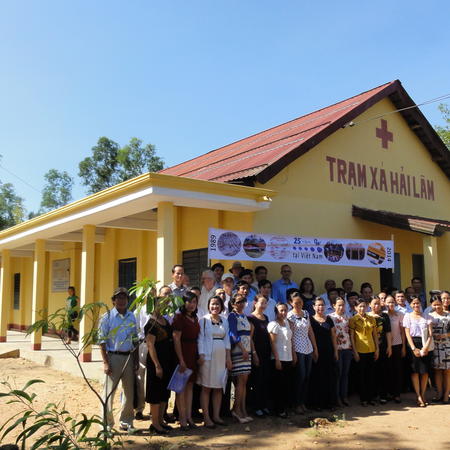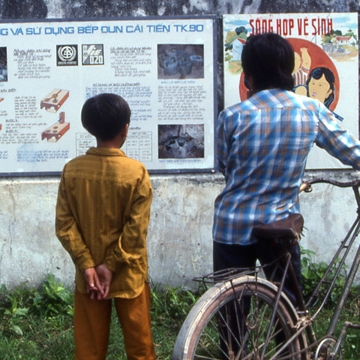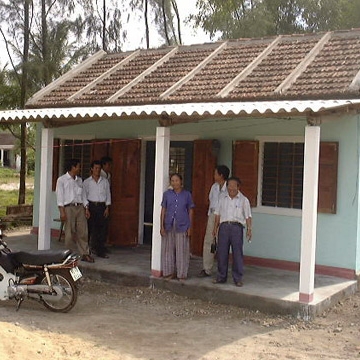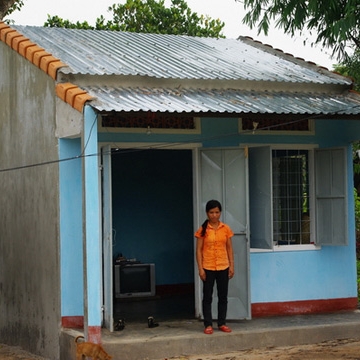Natural calamities expose under-quality construction works
VietNamNet Bridge – A sinkhole suddenly appeared on Hanoi’s Le Van Luong Road after a tropical typhoon, the Song Tranh hydro-power dam was cracked after earthquakes…
People question if these works were damaged by natural calamities or if natural calamities unmasked the poor quality of these works?
At around 7.30pm, August 19, a big hole appeared on the expanded Le Van Luong Road, a project to welcome Hanoi’s 1000th anniversary.
On August 20, the hole kept spreading to more than 20m wide, 30m long and 7m deep, causing serious traffic jams on Hanoi’s key role. The hole is very close to the USilk City apartment building, invested by the Song Da Thang Long JS Company.
Nam Cuong Group, the investor of expanded Le Van Luong Road, claimed the construction of USilk City apartment buildings as the reason causing the sinkhole on the road. Meanwhile, the investor of USilk City laid the blame on downpours.
An official from the Hanoi Traffic Inspection Agency said the under-construction project might have weakened the supporting material of the soil and broke the underground water drainage system, causing the sinkhole.
On August 21, the Hanoi Department of Transport and related agencies unexpectedly concluded that the hole was caused by downpours, resulted in depression. The conclusion was a big surprise because the department set up a working group to find out why the sinkhole appeared. Meanwhile, the independent inspection team did not confirm the reason yet.
The expanded Le Van Luong Road is 2.7km long, linking Hanoi downtown to Ha Dong district. The construction was kicked off in April 2009, with total investment of VND676 billion (around $340 million).
According to the Vietnam News Agency, this project is still under the warranty period. This incident has stirred up the public’s concern over the quality of this work.
Earlier, Hanoi people were worried about big cracks on the Thang Long Bridge, which still appeared after several times of mending. The cracks are said to cause many accidents, especially at night.
Vietnam News reported that nearly 40 serious accidents, with 12 fatalities and many others injured have occurred since January 2010, when the bridge cracks began appearing. Many cars and motorbikes have damaged their tires and wheels while travelling along the bridge.
The Vietnam Road Administration, as the builder of the bridge, was looking for partners to help develop a comprehensive project to repair the bridge and resolve any ongoing problems. The administration has also asked the Department of Road Management and Construction to supervise the repair work carried out by Bao Quan Investment and Construction Joint Stock Co, the project contractor, and hasten legal procedures to hand over operation of the bridge to the city.
Thang Long Bridge was built with Russian assistance in 1985, crossing the Red River to connect Noi Bai Airport with downtown Hanoi. Authorities spent roughly VND100 billion ($4.8 million) on resurfacing the bridge in 2009, but severe cracks have since appeared.
According to experts, one of the reasons for the poor quality of the road surface is that the rolling and pressing process of the stone mastic asphalt was below 120 degrees Celsius, negatively affecting the quality of surface. Rainwater draining systems also have not worked properly, also leading to stagnant water standing on and damaging the bridge's surface.
Another work that was also damaged in downpours is the major dam in Cua Dai, in the central province of Thanh Hoa. On October 5, 2007, because of downpours in the upstream region, a large volume of water flew to Cua Dai reservoir.
Under water pressure, around 100m of Cua Dai dam was broken. Flood swept away around 600,000cu.m of soil, causing losses of nearly VND200 billion (around $13 million). Thousand houses in Tho Xuan district were submerged.
Experts said that the incident originated from mistakes of the dam constructor.
The Cua Dat water reservoir is the largest national irrigation work and hydro electric-power plant on the Chu River, 17km from the Bai Thuong dam.
The Ministry of Agriculture and Rural Development is the main investor of the project along with contractors including the Vietnam Construction and Import-Export Joint Stock Cooperation (Vinaconex).
The VND7 trillion (around $470 million) project consists of two components. The Cua Dat reservoir--with a full capacity of 1.5 billion cubic meters, and Cua Dat hydro power plant. The project was kicked of in 2004.
The Song Tranh 2 hydro-power dam in the central province of Quang Nam was cracked and leaked in March 2012 after earthquakes.
Experts from the Ministry of Construction confirmed that water leakage at the dam was caused by errors in design.
Dr. Bui Trung Dung, deputy director of the State Agency for Assessing Quality of Construction Works and the leader of the Ministry of Construction’s inspection team at Song Tranh 2, said on March 21, that the dam does not have a water pipe connecting the left basement to the right basement to the downstream. Consequently, stagnant water easily runs through elastic slits and absorbs through the dam.
Mr. Dung also said that there were errors in design inspection and consulting-supervision. Moreover, the work is during the two-year period of warranty but the contractor did not work closely with the investor to fix errors.
The total investment capital in this project is VND5.194 trillion (around $350 million). The construction started in March 2006. The Song Tranh 2 reservoir is over 730 million cubic meters in capacity.
In HCM City, the South East Asia's largest underwater tunnel, Thu Thiem, was in early August reported to be plagued by cracks after just nine months of operations.
Thu Thiem tunnel is the first of its kind in Vietnam, consisting of four 1.5km long sections with a six-lane road.
In 2008, the four pre-built sections of the tunnel developed a series of 2-3 meters long cracks on the ceiling and walls. But these were fixed and passed inspection prior to the next stage in 2009.
When the tunnel was first put under water in 2010, the cracks appeared again at over 109 locations. The independent consultant, Oriental Consultants Company, said it was still within acceptable tolerance levels.
Thu Thiem Tunnel was approved for operation in November 2011. However just after nine months of operation, cracks were detected during routine maintenance by the HCM City Department of Transport.
Experts said that the tunnel was not cast properly or the tunnel casting technology is inappropriate to Vietnam’s condition.
Despite being in operation for only 2-3 years, many bridges in HCM City which cost hundred million USD have fallen into a state of disrepair, with cracks and erosion, according to Dan Tri.
Construction on the Thu Thiem Bridge, across Saigon River linking District 2 and Binh Thanh District, started in August 2005, and cost nearly VND1.5 trillion (US$71.4 million). The main part of the bridge was put into use since 2008 and the other parts were completed in late 2010.
However, since 2010, the bridge section in District 2 has showed serious signs of erosion. The contractors have been struggling to deal with the problem.
In September 2011, erosion spread and the bridge started showing cracks in a number of sections. Despite numerous repairs the deterioration has continued, with erosion reaching 10 meters at some points and concrete bars showing additional cracks.
On June 28, 2012, contractors made another attempt to fix the erosion problem but the cracks on the concrete bars have not yet been dealt with.
Phu My Bridge is in a similar state. Open to traffic since September 2009, and costing VND1.8 trillion (US$85.7 million), it is considered a symbol of HCM City. Nevertheless, just a short time after becoming operational the bridge had potholes in the section running through District 2.
Other problems have also been found at many overpasses along Vo Van Kiet Highway, which has only been open for one year.
Experts said that the areas where bridges are located have weak foundations. Lax geological surveying has led to the use of improper foundation consolidation techniques, which can be blamed for the cracks and subsidence. Such problems should be taken into account early in the design process.











